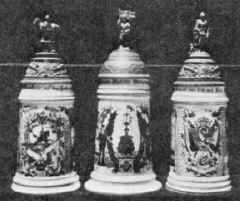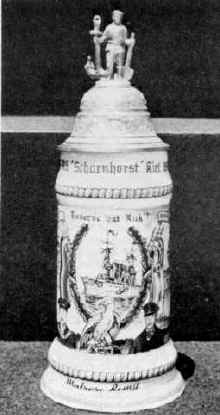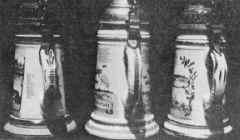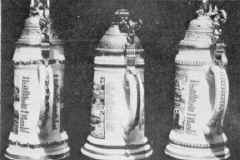Regimentals - Old or New
By Mario Pancino - originally published in Prosit in March, 1978The following review is based on a talk given by the author at the 1977 SCI convention in Milwaukee and represents an attempt to summarize the fundamental differences between "legitimate" regimental steins and the multitude of post-WW I reproductions.
In this article the term "reproduction" regimentals is used to mean all steins manufactured after WW I for tourist consumption or export, imitating the pre-WW I soldier's Reservistenkrug.
| A representative grouping of reproduction regimentals spanning the period 1920 thru today. |
There is probably no other single class of collectible stein so widely copied and generally misunderstood as the Imperial German soldier's souvenir, the "reservist" or "regimental" stein which flourished in popularity throughout the approximate time span 1880-1914.
To minimize the risk of buying a misrepresented stein (intentional or otherwise) there are a number of points to consider prior to purchase that can tell you if the Reservistenkrug you located in that out-of-the-way antique show or flea market is what at first glance it appears to be, or just another of the multitude of reproductions thoughtfully manufactured by the German souvenir industry anywhere from the 1920's through today.
To provide as useful a reference as possible yet not overly complicate the many points of comparison, let's break a stein into its basic components and look at it from the "ground up"! (Examples are shown following this tabular presentation.)
| Originals | Reproductions | |
| Ceramic
material and lithophanes (The large majority of reproduction regimental steins are made of porcelain with a lithophane in the base.) |
Generally
no
markings except for occasional mold numbers. If marked, the most common
producers are Merkelbach & Wick and "Paul Klutsch, Coblenz". Porcelain steins are similarly unlikely to be marked. Lithophanes typically portray a soldier and sweetheart, mother and sweetheart reading a letter, or an indoor/outdoor tavern scene. They are never erotic. Original regimental steins are not stamped "Germany" on the base. |
Pottery
reproductions frequently display the trademark of Simon Peter Gerz,
Höhr-Grenzhausen. Porcelain reproductions often use lithophanes of a nude or partially nude woman (see images below). The word "Germany" is frequently stamped on the base. |
| Bodies | May be either straight-sided or tapered bodies. Often there is a large amount of hand-painted "fill-in" on the design: for example, you can feel the buttons on the soldiers' tunics. The scenes on the body are all from a single branch of service - infantry, artillery, etc. - and never mixed (e.g., airplanes and Zeppelins). The dates of service are consistent with the uniforms and equipment depicted. (A stein dated 1888 should not illustrate a 1905 locomotive or 1902 Maxim machine gun.) | Tapered body shapes are common, and the use of transfer designs which were intended for cylindrical bodies will result in misalignment of the design on both sides of the handle. Reproductions often depict designs at the base and lip representing such patterns as twisted rope, interlocking acorn, leaves, etc. These designs are never found on originals. The transfer design is predominantly smooth, with little evidence of hand-painted fill-in. Scenes may be of mixed branches of the service, or inconsistent with the finial and thumblift. |
| Handles | The entire inside and outside curvature is smooth with no "bumps". The rear of the handle is either plain, has a simple straight stripe along its axis, or shows a stylized floral design. | Approximately 90% of all reproduction steins made to date have the characteristic "bump" on the inside of the handle. This "bump" is never found on originals. The rear of the handle almost always has some sort of design, and if it differs from the two mentioned at left, the stein is a repro! |
| Thumblifts | Thumblifts typically symbolize army corps district in which the reservist served. E.g., the lion represents Bavaria or Hesse; the Griffin, Baden; the Eagle, Prussia; etc. The thumblifts were seldom "stylized" except on pre-1900 steins. | Typical thumblifts on reproduction steins do not match the Army Corps district indicated by the scenes and the writing on the stein body. They frequently consist of "imaginary" shapes or figures, such as serpent heads or gargoyles, etc. |
| Lids and Finials | The outside of the lid is normally darker than the inside due to natural oxidation from exposure to the air. The finial always matches the branch of service indicated on the body. If a man's figure is included in the final, his uniform should be the same as that shown on the body scenes. This is especially true of the hat, which is often the most distinctive part of the uniform. | The pewter lid may show a uniform darker color both inside and out, which is a clear sign that it has been dipped in chemicals to simulate oxidation. The finials are frequently chosen for their appeal instead of being matched to the branch of service. A horse and rider (cavalry) are as likely to be found on an infantry stein as a man with pick and shovel (pioneer) is to be found on a naval stein. |
Lithophanes
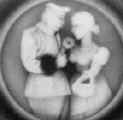 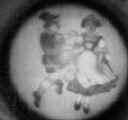 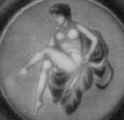 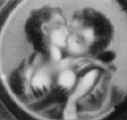 |
| Typical reproduction lithophanes showing both lack of detail and inappropriate themes. Although some reproduction steins have copies of old lithophanes, the above grouping are found only in newer pieces. |
Body shapes and Designs
|
|
Handles and Thumblifts
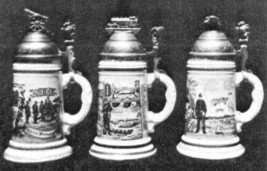 |
|
| Typical "bump" on inside of handle to be found on the majority of reproduction regimentals. This always denotes a reproduction, no exceptions! | The "serpent" design thumblift most often found on contemporary regimental reproductions. |
Chemical aging and Transfers
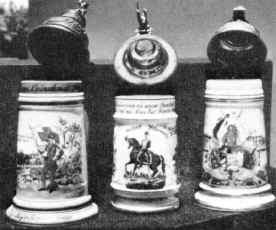 |
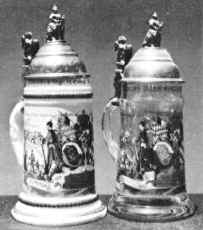 |
| Two examples of artificial (chemically dipped) aging applied to reproduction stein lids, compared to the interior of an old lid in the center. Chemically dipped lids will be uniform in color (patina) inside and out, while naturally oxidized lids will typically be brighter on the inside. | To save on production costs, scenes are often standardized for the reproduction regimental market. Above is an example of the same transfer used on two entirely different types of new steins. |
The above differences, of course, represent those most obvious and likely to be encountered when comparing original regimentals with reproductions of a later period.
Some of these guidelines have exceptions but those which categorically do not are so indicated, and particular attention should be paid to these points prior to purchase of a "suspect" piece.
In the final analysis, there is no substitute for experience in handling the actual pieces, both old and new; however, with the above in mind, obtaining that experience should be far less risky than you previously thought. Happy hunting!
